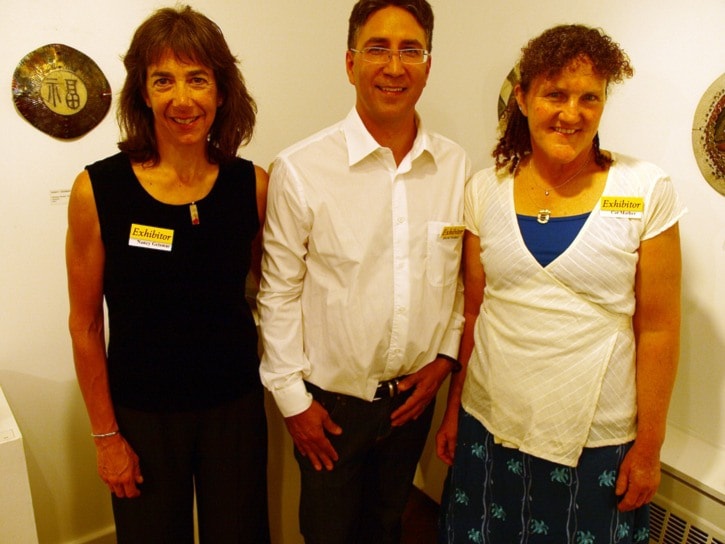Raku is a Japanese form of pottery where glazes are applied to the clay molds before they are placed in a burning hot kiln.
The beauty of it is that there’s no way of completely predicting what the end result will be. The colours vary depending on the type of glaze used but there’s a randomness to how they interact that means the final result will be a surprise.
“There’s a certain sense of Christmas there,” said David Walker.
“A certain sense of impending doom too,” he added with a chuckle.
Walker, Nancy Geismar and Cat Mather are displaying their Raku pottery at the Revelstoke Visual Arts Centre this month as part of their show Emerging from the Fire.
I chatted with them briefly at the opening of the show on Friday, eager to learn more about what Raku is. We were looking at a large, rhubarb leaf shaped dish that Mather created. The piece was notable for the green hue and thick black cracks running through it.
What I gathered was that the shapes are molded. Then a glaze is placed on and the mold is placed in the fire, which is where the Christmas magic happens.
“The smoke that’s created goes into any unglazed pottery,” Geismar said. “As an artist, you’re playing with the contrast, or glazed versus not glazed. When you see the black, there’s no glaze there.”
There’s more to it – different glazes create different colours. As well, the amount of oxygen the glazes are exposed to can change the colours – orange, red, green, blue, purple, white and/or copper.
“You apply the glaze but you really can’t see what it’s looking like,” Mather commented.
“When you apply the glaze to a raw piece it looks nothing like what it’s going to look like.”
That’s not to say it’s all completely random. Judging by the works on display, it’s clear a great deal of care and attention goes into each piece. The colours are vivid and the cracks are deliberate – it’s just the final hues and shapes that are somewhat unpredictable.
There’s also a decent possibility your piece will break apart due to the extreme temperatures they’re subject to. The pieces get heated up in a hurry to 1,900 F before being immersed in water that sits at room temperature. When Mather first did it, all of her pieces broke.
“I’m surprised I kept doing it because everything broke,” she laughed.
“I got much more consistent by the end just by firing more. It was amazing that you could control it more. When I first started firing Raku I thought there was no control.”
Geismar was the first of the three to take up Raku and she used to teach it at Mount Royal College in Calgary during the 1990s. She credited Mas Matsushita for being instrumental in getting the art form going in Revelstoke.
“Mas was the one who galvanized it,” she said. “He’s been a real energizing force in the town and a good mentor.”
The three of them do their firings behind the arts centre – it’s too hazardous to one’s health to do indoors. They do it as a group – making for a good social activity.
“It’s a very social, artistic thing to do,” said Walker.
